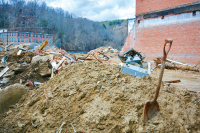From the darkness to the light – literally
 Legend has it that curious fishermen watching trout seemingly disappear into Humpback Mountain back in 1822 discovered an entrance into what is now known as Linville Caverns. Henry E. Colton of eastern North Carolina and once a state geologist for the state of Tennessee was one of the discoverers. Colton wrote about the discovery in an 1858 issue of the NC Presbyterian: “… we emerged into an immense passage, whose roof was far beyond the reach of the glare of our torches, except where the fantastic festoons of stalactites hang down within our touch. It looked like the arch of some grand old cathedral, yet it was too sublime, too perfect in all its beautiful proportions, to be anything of human …”
Legend has it that curious fishermen watching trout seemingly disappear into Humpback Mountain back in 1822 discovered an entrance into what is now known as Linville Caverns. Henry E. Colton of eastern North Carolina and once a state geologist for the state of Tennessee was one of the discoverers. Colton wrote about the discovery in an 1858 issue of the NC Presbyterian: “… we emerged into an immense passage, whose roof was far beyond the reach of the glare of our torches, except where the fantastic festoons of stalactites hang down within our touch. It looked like the arch of some grand old cathedral, yet it was too sublime, too perfect in all its beautiful proportions, to be anything of human …”
Coping with gray treefrogs
 The call of, “Come see! A frog!” is one oft repeated in the Hendershot household from spring through fall as toads go by both names – toad and/or frog. So the other morning when Izzy called to, ”Come see this frog!” I was expecting another toad. But when I walked to the front door, there on one of the glass panes next to the door was a treefrog – round saucer toes keeping it firmly planted on the glass.
The call of, “Come see! A frog!” is one oft repeated in the Hendershot household from spring through fall as toads go by both names – toad and/or frog. So the other morning when Izzy called to, ”Come see this frog!” I was expecting another toad. But when I walked to the front door, there on one of the glass panes next to the door was a treefrog – round saucer toes keeping it firmly planted on the glass.
Homeward bound
 After Jersey and the Big Apple (see last week’s Naturalist’s Corner — www.smokymountainnews.com/outdoors/item/7554-famous-nyc-offspring), it was time for a leisurely trip home. We headed south to Cape May and took the Cape May-Lewes Ferry across the Delaware Bay to Lewes, Del. The trip across takes about an hour-and-a-half. It provides a view of three lighthouses, Cape May Light, Harbor of Refuge Light and Delaware Breakwater East End Light. The ferry is also linked to another feature on our southward trek home — the Chesapeake Bay Bridge and Tunnel. Service at Cape May-Lewes began in 1964 with a fleet of four ferries purchased after the completion of the CBB&T ended their route across the bay from Cape Charles.
After Jersey and the Big Apple (see last week’s Naturalist’s Corner — www.smokymountainnews.com/outdoors/item/7554-famous-nyc-offspring), it was time for a leisurely trip home. We headed south to Cape May and took the Cape May-Lewes Ferry across the Delaware Bay to Lewes, Del. The trip across takes about an hour-and-a-half. It provides a view of three lighthouses, Cape May Light, Harbor of Refuge Light and Delaware Breakwater East End Light. The ferry is also linked to another feature on our southward trek home — the Chesapeake Bay Bridge and Tunnel. Service at Cape May-Lewes began in 1964 with a fleet of four ferries purchased after the completion of the CBB&T ended their route across the bay from Cape Charles.
Famous NYC offspring
 New York City is big, bustling and in July – hot, but there are always entertaining and even educational ways to escape the heat. The planets aligned just right giving both Denise and me the entire July Fourth week off.
New York City is big, bustling and in July – hot, but there are always entertaining and even educational ways to escape the heat. The planets aligned just right giving both Denise and me the entire July Fourth week off.
We donned our tourist attitudes and headed north for a visit with Denise’s sister in Eastampton, New Jersey and a short train ride and a day in the Big Apple with Izzy (10) and Maddie (6).
Kudos, Gov. Perdue
 News outlets began reporting Sunday night (July 1) that North Carolina Gov. Bev Perdue vetoed Senate Bill 820, which would have allowed energy companies to use a process known as hydraulic fracturing, a.k.a. fracking, to drill for natural gas in the state. Fracking is the technique of injecting drilling fluids composed of water, sand and toxic chemicals under intense pressure into shale or other rock formations, fracturing them and allowing the trapped natural gas to escape into the drilling casing.
News outlets began reporting Sunday night (July 1) that North Carolina Gov. Bev Perdue vetoed Senate Bill 820, which would have allowed energy companies to use a process known as hydraulic fracturing, a.k.a. fracking, to drill for natural gas in the state. Fracking is the technique of injecting drilling fluids composed of water, sand and toxic chemicals under intense pressure into shale or other rock formations, fracturing them and allowing the trapped natural gas to escape into the drilling casing.
Wielding a symbolic veto against fracking’s unknown downsides
 Gov. Perdue has to be weary. This weariness was apparent months ago when she declared she would not seek re-election. Her vetoes are little more than symbolic with the current make up of the General Assembly and here she is with another bombshell on her desk — fracking in North Carolina.
Gov. Perdue has to be weary. This weariness was apparent months ago when she declared she would not seek re-election. Her vetoes are little more than symbolic with the current make up of the General Assembly and here she is with another bombshell on her desk — fracking in North Carolina.
Here’s the simple fracking definition according to the oil and gas industry: hydraulic fracturing is the benign process of injecting fluids that are primarily composed of water and sand and maybe a couple of chemicals, at high pressure, into shale or other rock formations to create cracks that then allow the natural gas to escape and be captured.
Check your vital signs
 The Mountain Resources Commission, the Blue Ridge National Heritage Area, the U.S. Forest Service and the National Environmental Modeling and Analysis Center at the University of North Carolina at Asheville have created a Western North Carolina Vitality Index. The purpose is to provide local governments, various interest groups and the public with easy-to-understand data specific to the western end of the state to promote more informed decisions with regard to resource use and community planning. The Index expands and enhances the Forest Service’s Western North Carolina Report Card on Forest Sustainability.
The Mountain Resources Commission, the Blue Ridge National Heritage Area, the U.S. Forest Service and the National Environmental Modeling and Analysis Center at the University of North Carolina at Asheville have created a Western North Carolina Vitality Index. The purpose is to provide local governments, various interest groups and the public with easy-to-understand data specific to the western end of the state to promote more informed decisions with regard to resource use and community planning. The Index expands and enhances the Forest Service’s Western North Carolina Report Card on Forest Sustainability.
Bog is good
Mountain bogs are some of the rarest and most imperiled natural habitat in the country. They are generally small and scattered across the landscape often isolated from other wetlands. This isolation can create unique habitats, which in turn create unique flora and fauna. Bogs are home to several federally endangered and/or threatened species including bog turtles, mountain sweet pitcher plant, bunched arrowhead, swamp pink and others.
Paint Rock
As one whom is often standing on the shoulder of the road peering through binoculars, I’m accustomed to people slowing down and asking, “What are you looking at?”
Well last Saturday I got to turn the tables. I was zooming down River Road along the French Broad River in Hot Springs marking points for my point-surveying accomplice, Bob Olthoff, when I realized I had just missed my turn, which was the last Forest Service road in North Carolina before hitting the Tennessee line. I decided to continue to the state line, just to be certain and that’s where I saw a small group of people standing below a rock outcropping with binoculars and cameras pointed towards the precipice. I passed and turned around and on the way back couldn’t resist. I stopped and asked, “What did you guys find?”
I’m glad I did. They explained they were looking at some American Indian petroglyphs. I could see the reddish-orange designs on a section of rock about 50 feet up. They explained that the Paint Clan of the Cherokee Indians had created the petroglyphs.
I think I have lamented in this column before that while doing bird points for the Forest Service from Hiwassee Dam to Grandfather Mountain and from Roan Mountain to Mt. Mitchell to Brevard, I often encounter a lot of cool stuff. But alas, the “job” part of this endeavor – having to survey all the points within a six-week time frame – often means there is not much time for following those enticing side trails.
I have traveled River Road at least once a year since 2007. And where you turn onto River Road from N.C. 209 there is an historical marker that states, “Pictographs on cliff face were created by Indians ca. 2500 B.C. & long have been landmark for travelers. 5 1/2 mi. N.W.” But I have almost always turned right on FS Road 468 to get to my points, went in, surveyed and beat it back out to 209 and on to other points, never taking the time to try and track down the pictographs or petroglyphs. But today, someone had found them for me.
I did a little internet research when I got home to learn more about the site. It seems botanist Andre Michaux had made notes about a “red-painted rock” during his travels back in 1796. And as early as 1799, a Tennessee border survey noted that campfire soot was obscuring some of the petroglyphs. Advertising for a stagecoach line in 1859 stated that the line crossed the mountains in full view of the Painted Rocks.
The 1799 comments were from surveyor John Strother, who kept a diary while surveying the North Carolina-Tennessee border. Strother wrote, “Friday 28th. Set out very early and proceeded on the line about 4 m to the Painted rock on F. B. (French Broad) River, about 5 m below the Warm Springs [Warm Springs was the original name for Hot Springs]; measured the height of the rock and found it to be 107 feet 3 inches high from the top to the base; it rather projects over. The face of the rock bears but few traces of its having formerly been painted — owing to its being smoked by pine knots and other wood from a place at its base where Travellers have frequently camped — in the year 1790 it was not much smoked; the Pictures of some human’s — wild beasts fish & fowls were to be seen plainly made with red paint, some of them 20 & 30 feet from its base.”
A study in 2006 revealed the petroglyphs were around 5,000 years old. The pigments used were said to be of superior quality and complex design. All of the ingredients were determined to be local.
The Paint Clan were noted as healers and sorcerers. They were the keepers of ritual and ceremony and the only ones allowed to make a special red paint used for ceremonial purposes.
One explanation for Paint Rock is that it was a stopping point for the Cherokee on their way to the healing hot springs. It was a place for prayer and contemplation – the perfect setting for the Paint Clan’s powerful red dye.
(Don Hendershot is a writer and naturalist. He can be reached a This email address is being protected from spambots. You need JavaScript enabled to view it..)
Lily here and lily there
I was in the Grandfather District of the Pisgah National Forest the other morning preparing to go to one of my Forest Service bird points when I noticed two tall white flowers at the edge of the woods. My first thought was fly poison, Amianthium muscaetoxicum, but then I thought it’s a little early for fly poison; I ventured over for a closer look. I found two, nearly 3-feet tall, stalks with terminal racemes of white flowers about 5 inches in length. So at a distance, there is a resemblance to fly poison, but upon closer inspection there were obvious differences.
The lily I had stumbled upon the other morning is known as turkeybeard or eastern turkeybeard, Xerophyllum asphodeloides. It gets its common name from the wiry grass-looking clump of basal leaves that, with a little imagination, could resemble the “beard” that protrudes from the breast of Tom Turkey. The basal leaves of fly poison are a little more lily-like – flat and up to 3/4 of an inch wide. Turkeybeard also has long (4-5 inch) needle like cauline (stem) leaves that are smaller near the top of the plant. The cauline leaves of fly poison are only about an inch long.
The genus Xerophyllum has two North American species, X. asphodeloides (turkeybeard) in the east and X. tenax or beargrass in the Northwest. Turkeybeard is found in two disjunct and, at first glance, totally different habitats. It is found in the pine barrens of southern New Jersey and in xeric (dry) oak and pine communities at mid to high elevations along the Southern Appalachians from Virginia and West Virginia through the Carolinas to Georgia. There are historic records from Delaware and Kentucky.
While these two habitats appear to be opposite ends of the spectrum, they actually have a lot in common. They are both composed of dry, acidic, sandy or rocky soils and share other same or similar plant species like blackjack oak, pitch pine and blueberries.
Turkeybeard is recorded from 41 counties across its range. It is endangered in parts of its range and has been included in the U.S. Center for Plant Conservation’s National endangered Plant Collection.
Turkeybeard is well suited for its dry environment. The genus name, Xerophyllum, means “dry-leaved” and the thin coarse leaves conserve water by minimizing evaporation. In the Southern Appalachians, Turkeybeard is most often found on west or northwest-facing slopes and its primary source of water is from rain and/or fog.
Recent studies by Norman A. Bourg and others at the University of Maryland have shown that turkeybeard seems to benefit from fire and suggests that it could be fire-dependent. The plant’s large rhizome could allow it to store water and become dormant underground where it could survive a fire. Seeds collected in 1988 by the New England Wildflower Society were still viable in 1995, suggesting that turkeybeard is capable of seed-banking, so there would be seed available after a fire or other disturbance.
The fire scenario fits well with the turkeybeard I discovered in Grandfather the other day. I’ve been doing that point since 2007 and I enter the woods at the same point every year and within a week or 10 days of the same date and this is the first year I’ve seen the flowers. I could have walked by the basal leaves without noticing them but there’s no way to miss the flowers. And there was a fire a couple of years ago. I don’t know if it was a wildfire or a controlled burn but there were no flowers in the years before the fire but lily is definitely present now.









